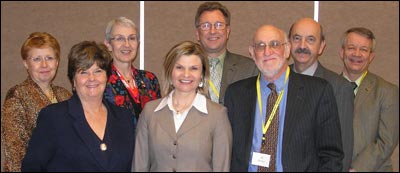Improved Transportation Coordination Endorsed at Summit
Posted: Apr 23, 2008
Mobility for residents of North Dakota took a significant move forward last week with pledges from Lieutenant Governor Jack Dalrymple and Dave Leftwich of the North Dakota Department of Transportation to work to improve coordination among transit providers in the state.
"The endorsement of this concept puts it on the front burner, politically, and will help make it a priority across the state," notes Carol Wright, of the Small Urban & Rural Transit Center (SURTC), a part of NDSU's Upper Great Plains Transportation Institute. The endorsements came during a Transit Coordination Summit April 9 in Bismarck. The event was sponsored by SURTC and AARP North Dakota.
Within transportation, the terms coordination, cooperation, and collaboration all refer to groups of people, programs, and/or funding sources working together to improve services to clients through a more unified approach. "The underlying assumption is that a group of entities working together can create a greater benefit for society than individual programs and entities working separately," explains SURTC director Jill Hough.

Speakers at the Transit Coordination Summit included (from left to right): Nancy Smith, AARP, national committee chair; Jeanne Erickson, CTAA; Janis Cheney, AARP North Dakota; Jill Hough, SURTC; Ron Hynes, FTA; Al Abeson, national coordination advocate; Jon Mielke, SURTC; and Dave Leftwich, NDDOT.
Nearly 100 transit managers, county commissioners, human service providers and others attended the conference. "The idea was to get past the territorialism that sometimes occurs," Wright said. "We wanted them to view the big picture of mobility in the state and see where they fit."
The keynote speaker at the summit was Alan Abeson, a leading national advocate for transportation coordination. Abeson recently retired as director of Easter Seals Project Action, an initiative that promotes cooperation between the transportation industry and the disabled community to enhance mobility. Abeson contributed significantly to the development of the Americans with Disabilities Act. In his address, he emphasized the concrete results that could be attained through coordination.
Other speakers included Nancy Smith, AARP National Committee Chair; Ron Hynes Deputy Associate Administrator of the Office of Research, Demonstration and Innovation with the Federal Transit Administration; Jeanne Erickson Region VIII United We Ride Ambassador with the Community Transportation Association of America; and Janis Cheney, state director for AARP North Dakota.
SURTC conducted a study for the NDDOT to explore the potential of increased transportation coordination in 2004. Since then, improved coordination has been an underlying theme in a number of SURTC research projects.
Improved mobility through coordination and other means was also a theme as SURTC's parent organization, the Upper Great Plains Transportation Institute, recently held eight regional workshops across the state. At the workshops, Institute staff members outlined concerns related to mobility and infrastructure and gathered input on how to deal with those concerns. Information from those workshops was presented at the summit by Jon Mielke, a SURTC researcher who has helped organize the workshops.
"As the demographics of North Dakota and other rural states continue to change, we are going to need to pay particular attention to the mobility needs of those who remain in rural areas," Wright notes. "The growing proportion of elderly residents will have significant transportation needs. To make the best use of resources and to provide the highest level of mobility to rural residents will require that agencies and organizations continually work to coordinate their services."
Published in NDSU's staff newsletter
It's Happening at State
Apr. 23, 2008